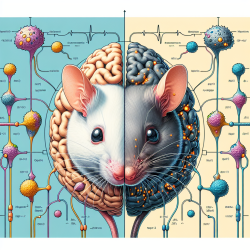The study of genetic factors contributing to autism spectrum disorders (ASD) has made significant strides, with the SHANK3 gene emerging as a critical player. The research article titled Ultrastructural analyses in the hippocampus CA1 field in Shank3-deficient mice, provides valuable insights into the synaptic alterations associated with mutations in this gene. This blog will discuss the findings and their implications for practitioners and researchers in the field of autism.
The Role of SHANK3 in Autism
The SHANK3 gene encodes a protein that is integral to the postsynaptic density (PSD) of neurons, playing a crucial role in synaptic function and plasticity. Mutations or deletions in this gene are linked to Phelan-McDermid syndrome (PMS) and have been identified as a cause of autism. Understanding how these genetic changes manifest at the synaptic level is essential for developing targeted interventions.
Key Findings from the Study
The study focused on Shank3-deficient mice, examining synapse density, postsynaptic density length, and perforated synapse density at different developmental stages. Here are some key findings:
- No Significant Change in Synapse Density: Both Shank3 heterozygous and homozygous mice showed no significant difference in overall synapse density compared to wildtype mice.
- Increased Perforated Synapses: At 5 weeks of age, Shank3 heterozygous mice exhibited significantly higher numbers of perforated synapses compared to wildtype and homozygous counterparts. This increase did not persist into adulthood.
- Morphological Compensation: Despite expectations, major structural changes were not evident, suggesting potential compensatory mechanisms at play involving other proteins like Shank1 and Shank2.
Implications for Practitioners
The findings suggest that while overt structural changes may be compensated for, subtle synaptic alterations could contribute to the functional impairments observed in ASD. Practitioners should consider these nuances when developing therapeutic strategies. Enhancing synaptic plasticity through targeted therapies could potentially mitigate some behavioral symptoms associated with SHANK3 mutations.
The Need for Further Research
This study highlights the importance of investigating subtle morphological changes at the synapse level. Future research should aim to:
- Expand Age Range: Investigate younger developmental stages to understand early onset alterations.
- Larger Sample Sizes: Conduct studies with larger populations to validate findings and reduce type I error risks.
- Molecular Mechanisms: Explore specific protein level changes that occur due to SHANK3 deficiency.
The insights gained from such research could pave the way for novel interventions targeting synaptic function in ASD.
To read the original research paper, please follow this link: Ultrastructural analyses in the hippocampus CA1 field in Shank3-deficient mice.










